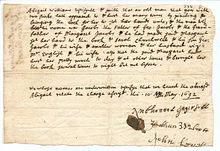Abigail Williams: Difference between revisions
m rvv |
|||
| Line 8: | Line 8: | ||
==''The Crucible''== |
==''The Crucible''== |
||
Williams is one of the central characters in [[Arthur Miller]]'s play ''[[The Crucible]]''. Although Miller based this play on the historical events, he took dramatic license with them. For example, ''The Crucible'' includes a wholly unhistorical amorous liaison between Abigail Williams and [[John Proctor]], and to make it more believable Miller raised Williams' age to 17 and lowered Proctor's historical age of 60 to about 40. The playwright likewise made the fictionalized Williams and Proctor fairly near neighbors, although the historical people lived eight miles apart. At the end of the play, Miller lists the fates of each surviving character. For Williams, Miller wrote that, according to legend, four years after the witch trials she had become a cheap prostitute in Boston. |
Williams is one of the central characters in [[Arthur Miller]]'s play ''[[The Crucible]]''. Although Miller based this play on the historical events, he took dramatic license with them. For example, ''The Crucible'' includes a wholly unhistorical amorous liaison between Abigail Williams and [[John Proctor]], and to make it more believable Miller raised Williams' age to 17 and lowered Proctor's historical age of 60 to about 40. The playwright likewise made the fictionalized Williams and Proctor fairly near neighbors, although the historical people lived eight miles apart. At the end of the play, Miller lists the fates of each surviving character. For Williams, Miller wrote that, according to legend, four years after the witch trials she had become a cheap prostitute in Boston. |
||
{{salem}} |
{{salem}} |
||
Revision as of 19:13, 17 September 2007

Abigail Williams was one of the original and foremost accusers in the Salem witch trials of 1692. Williams was eleven years old at the time.
After Betty Parris, a nine-year-old cousin of Williams, became seemingly ill, Williams began to show alike symptoms. According to Rev. Deodat Lawson, an eye witness, she began to have fits in which she ran around rooms, flailing her arms, ducking under chairs and trying to climb up the chimney. These behaviors brought attention to her, as they had with Parris. A local doctor, thought to have been William Griggs, suggested bewitchment as the cause. The girls were eventually asked to name their supposed tormentors. They did so, thus bringing about the witch trials. Nothing is surely known of what happened to Williams after the trials ended.
The Crucible
Williams is one of the central characters in Arthur Miller's play The Crucible. Although Miller based this play on the historical events, he took dramatic license with them. For example, The Crucible includes a wholly unhistorical amorous liaison between Abigail Williams and John Proctor, and to make it more believable Miller raised Williams' age to 17 and lowered Proctor's historical age of 60 to about 40. The playwright likewise made the fictionalized Williams and Proctor fairly near neighbors, although the historical people lived eight miles apart. At the end of the play, Miller lists the fates of each surviving character. For Williams, Miller wrote that, according to legend, four years after the witch trials she had become a cheap prostitute in Boston.
